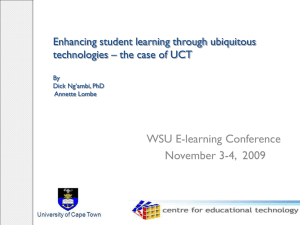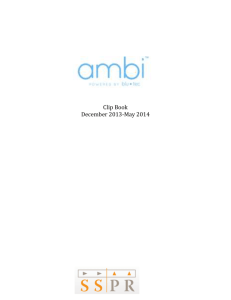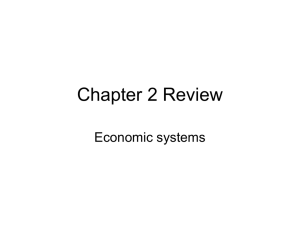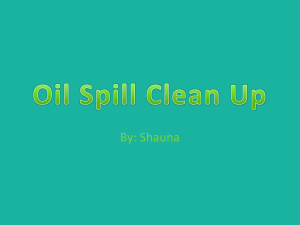M-AMBI - Perseus
advertisement
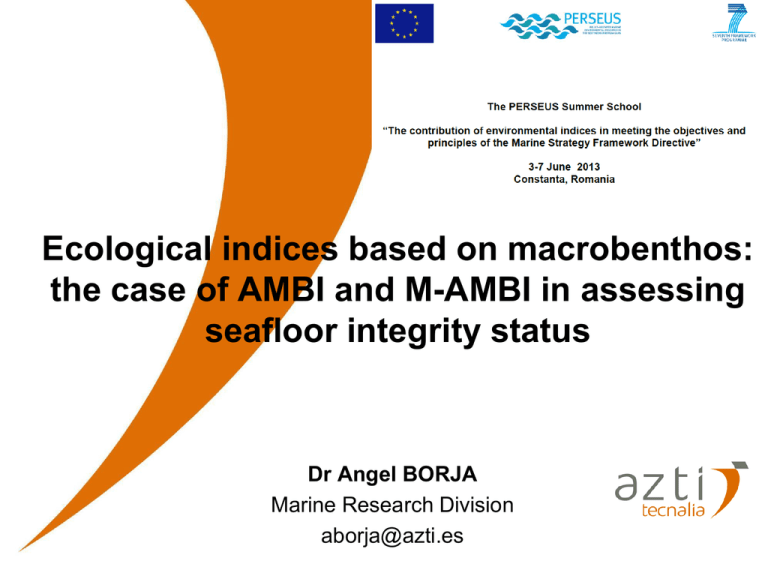
Ecological indices based on macrobenthos: the case of AMBI and M-AMBI in assessing seafloor integrity status Dr Angel BORJA Marine Research Division aborja@azti.es Introduction Advantages Ecological theory Development Validation Applications (response to pressures) Ecological status (M-AMBI) M-AMBI Disadvantages Introduction: Impacts on benthos AMBI (AZTI’s Marine Biotic Index) as indicator of impact AMBI Reference conditions and status Response to pressures Advantages and disadvantages Introduction AMBI M-AMBI Advantages Disadvantages Impacts on benthos • Advantages of using it as indicator: – – – – – Real affection to biota (species-community level) Global indicator of pollution Integrated information through time Short life-span species: fast recovery (good change indicators) Easy-work ecosystem component • Disadvantages as indicator: – Taxonomists are needed – High economic cost – Slow delivery of results Introduction AMBI M-AMBI Advantages Disadvantages Impacts on benthos Which kind of biological approaches can be used?: Qualitative values: cover (for macroalgae), etc. Basic variables: taxonomy lists, richness, density, biomass, diversity and evenness Different analyses: ABC curves, MDS, Canoco, Primer, multimetric approaches, etc. Biotic indices: old methods, but recently refreshed by new indices. In our case, the AMBI (AZTI Marine Biotic Index) and M-AMBI (multivariate AMBI). They can be used in the MSFD for 2 of the indicators of seafloor integrity: sensitive/opportunistic species (AMBI) and multimetric indices (M-AMBI) Introduction AMBI M-AMBI Advantages Impacts on benthos Developing an index Borja, A., D. Dauer, 2008. Ecological Indicators, 8: 331-337. Disadvantages Introduction AMBI M-AMBI Advantages Disadvantages Ecological theory of AMBI • Adaptive strategies – Reproductive (r): short life-cycle, fast growth, early sexual maturity, larvae through the year and direct development = opportunists – Competitive (k): long lifecycle, slow growth, high biomass. – Tolerant (T): species not affected – Not viable: azoic situation PEARSON & ROSENBERG (1978) MODEL Peak of opportunistic species Richness Biomass Abundance + ORGANIC MATTER ENRICHMENT - Borja, A., J. Franco, V. Pérez, 2000. Marine Pollution Bulletin, 40(12): 1100-1114. Introduction AMBI M-AMBI Advantages Disadvantages Ecological theory of AMBI • Initial State = Normal zone – Rich biocenosis in individuals and species – Many species exclusive from the biocenosis, linked to grain-size – High diversity • Slight unbalance = Ecotone I = Disequilibrium zone – Exclusive species decrease in number and abundance – Tolerant species proliferate, pioneer species appear – Diversity decreases • Pronounced disequilibrium = Disequilibrium zone = Polluted – Representative species disappear, opportunists dominate – Diversity very low – In extreme cases presence of 1 or 2 species • Fauna disappears = Azoic Zone Borja, A., J. Franco, V. Pérez, 2000. Marine Pollution Bulletin, 40(12): 1100-1114. Introduction AMBI M-AMBI Advantages Disadvantages Ecological theory of AMBI - Group I: Species very sensitive to disturbance, present under unpolluted conditions (initial state): specialist carnivores, some depositfeeding tubicolous polychaetes. - Group II: Species indifferent to disturbance, present in low densities, non-significant variations with time (from initial state, to slight unbalance), suspension feeders, less selective carnivores, scavengers. - Group III: Species tolerant to excess organic matter enrichment. They occur under normal conditions, but are stimulated by organic enrichment (slight unbalance situations), surface deposit-feeding species, as tubicolous spionids. - Group IV: Second-order opportunistic species (slight to pronounced unbalanced situations). Mainly small sized polychaetes: subsurface deposit-feeders, such as cirratulids. - Group V: First-order opportunistic species (pronounced unbalanced situations). These are deposit-feeders, which proliferate in reduced sediments. Borja, A., J. Franco, V. Pérez, 2000. Marine Pollution Bulletin, 40(12): 1100-1114. Introduction AMBI M-AMBI Advantages Disadvantages Ecological theory of AMBI Borja, A., J. Franco, V. Pérez, 2000. Marine Pollution Bulletin, 40(12): 1100-1114. Normal Unbalanced Polluted Very polluted Group I Sensitive Group II Indifferent Group III Tolerant Group IV Opportunistic Group V Opportunistic © AZTI-Tecnalia Increasing gradient of impact or disturbance Introduction AMBI M-AMBI Advantages Disadvantages Ecological theory of AMBI AMBI development AMBI = ((0 * %GI) + (1.5 * %GII) + (3 * %GIII) + (4.5 * %GIV) + (6 * %GV))/100 Dominating Ecological Group I PERCENTAGE OF GROUPS 100 Biotic 90 AMBI Coefficient 80 0.0 < AMBI BC 70 0.2 60 1.2 0.2 < AMBI BC 50 3.3I 1.2 < AMBI BC 40 3.3 < AMBI BC 4.3 30 4.3 < AMBI BC 20 5.0 10 5.5 5.0 < AMBI BC 5.5 < AMBI BC0 0 6.0 Azoic WFD III III IV-V 1 UNPOLLUTED V Azoic II 2 5 Benthic Community Health 6 Site Disturbance Classification AZOIC SEDIMENT 1 0 POLLUTION BIOTIC AMBI COEFFICIENT 2 3 4 Normal V Undisturbed Impoverished Unbalanced Slightly disturbed Transitional to pollution Meanly disturbed IV Polluted Transitional to heavy pollution Heavily disturbed Heavy3 polluted 4 5 6 7 BIOTIC INDEX Azoic Extremely disturbed SLIGHTLY POLLUTED MEANLY POLLUTED HEAVILY `POLLUTED EXTREM. POLLUTED HIGH GOOD MODERATE POOR BAD STATUS STATUS STATUS STATUS STATUS INCREASING POLLUTION Introduction AMBI M-AMBI Advantages Disadvantages Ecological theory of AMBI AMBI development • • You can consult our web page (http://ambi.azti.es) and obtain our free AMBI software to calculate and represent the index. This approach includes the classification of 6,500 species from the Atlantic, Mediterranean, Pacific, etc. (it is updated regularly). Introduction AMBI M-AMBI Advantages Disadvantages Ecological theory of AMBI AMBI development AMBI validation 3006 200 5 (ml.l -1) POTENCIAL REDOX (m V) OXYGEN DISSOLVED OXÍGENO DISUELTO (mV) POTENTIAL REDOX 4007 100 4 0 3 -100 2 -200 0 0 1 1 2 2 3 3 4 4 5 5 AMBI ÍNDICE BIÓTICO 6 6 7 7 BIÓTICO ÍNDICEAMBI Borja, A., J. Franco, V. Pérez, 2000. Marine Pollution Bulletin, 40(12): 1100-1114. Introduction AMBI M-AMBI Advantages Disadvantages Ecological theory of AMBI AMBI development AMBI validation 100 300 800 250 90 2,0 25080 700 LEAD Pb Cr CHROMIUM CADMIUM Cd ZINC Zn COPPER Cu 200 600 70 1,5 200 500 60 150 400 15050 1,0 40 300 100 10030 200 20 0,550 50 10 0 0 100 00 0,0 0 0 00 0 1 1 11 1 2 2 2 33 44 55 3 4 5 3 4BIÓTICO 2 ÍNDICE 3 BIÓTICO 4 5 5 ÍNDICE AMBI AMBI ÍNDICEAMBI BIÓTICO ÍNDICE BIÓTICO ÍNDICE BIÓTICO AMBI AMBI 66 6 6 6 77 7 7 7 Borja, A., J. Franco, V. Pérez, 2000. Marine Pollution Bulletin, 40(12): 1100-1114. Introduction AMBI M-AMBI Advantages Disadvantages Ecological theory of AMBI AMBI development AMBI validation %ERL-Hg PORCENTAJE PERCENTAGE PORCENTAJE PERCENTAGE PORCENTAJE PERCENTAGE PERCENTAGE PORCENTAJE 100100 %ERL-Ni %ERL-As 100 %ERL-Cr 100 90 90 %ERL-Cd %ERL-Pb 90 %ERL-Cu 80 90 80 80 70 80 70 70 60 60 60 70 50 50 50 40 60 40 30 50 30 40 20 40 20 30 10 30 10 20 0 0 1 2 3 4 5 6 20 0 10 0 0 1 2 3 4 5 10 INDICEAMBI BIÓTICO 0 1 2 3 4 5 AMBI INDICE BIÓTICO 0 0 1 2 3 AMBI 4 5 ÍNDICE BIÓTICO %ERL-DDT %ERL-PAH %ERL-PCB 7 6 7 6 6 7 7 AMBI INDICE BIÓTICO Borja, A., J. Franco, V. Pérez, 2000. Marine Pollution Bulletin, 40(12): 1100-1114. Introduction AMBI M-AMBI Advantages Disadvantages Ecological theory of AMBI AMBI development AMBI validation Applications: submarine outfall (Barcelone) Cardell, M. J. (1996). Estructura y dinámica de la macrofauna bentónica en sedimentos marinos sometidos a vertidos domésticos e industriales: Efecto de las SPAIN aguas y lodos residuales de Badalona la planta depuradora de Sant Adrià de Besòs (Barcelonès). Ph.D. Thesis, Universidad de Barcelona, 450 pp. Ros, J., Cardell, M.J., Alva, V., Palacín, C. & Llobet, I. (1990). Comunidades sobre fondos blandos afectados por un aporte masivo de lodos y aguas residuales 33 (litoral frente a Barcelona, Mediterráneo Occidental): Resultados preliminares. Actas VI Simposio Ibérico de Estudios del Bentos Marino, Palma de Mallorca, 1, 407-423. Besòs River 32 11 27 8 28 26 Barcelona 4 25 21 34 1 36 37 2 5 20 38 14 3 35 30 22 19 24 18 15 40 31 39 23 16 13 17 12 29 0 1 2 3 4 5 6 7 Introduction AMBI M-AMBI Advantages Disadvantages Ecological theory of AMBI AMBI development AMBI validation Applications: Nervión estuary (Spain) Adapted from Borja et al., 2006 (MEPS) 7 90% 6 70% 5 60% 4 50% 40% 3 30% 2 20% 1 10% IV III II 2006 2005 2004 2003 2002 2001 2000 1999 1998 1997 1996 1995 AHV closed Water treatment started V 1994 1993 1992 1991 0 1990 0% Biological treatment I AMBI Oxygen sat. AMBI 80% 1989 Oxygen Saturation Ecological Groups 100% AMBI v 4 3 Introduction 2 1 0 0 200 400 AMBI M-AMBI Advantages Disadvantages Ecological theory of AMBI AMBI development AMBI 600 validation 800 1000 1200 1400 Applications: drill-cuttings (North Sea) DISTANCE (m) Beryl B 7 7 5 4 3 2 1 0 0 AMBI values AMBI values AMBI AMBI values 6 Beryl B HD 2 MD y = 0.5707Ln(x) - 0.8734 5 76 4 6 3 5 5 2 R = 0.8351 SD 44 1 UD 0 3 5000 3000 1000 500 3 2 12 7 01 6 5 2000 950 500 130 0 4 AMBI values 7 ED 6 3 2000 1 2 1 4000 10 250 250 500 1000 3000 5000 ED 250 500 850 MD SD UD HD 1200 2000 3000 5000 80001000 10000 10000 12000 SD DISTANCE (m) TOTAL ORGANIC CARBON TOTAL HYDRO CARBON UD 0 500 HD MD 6000 100 5000 3000 1000 ED 250 250 500 1000 3000 5000 Muxika, I., A. Borja, W. Bonne, 2005. Ecological Indicators, 5: 19-31. 100000 Introduction AMBI M-AMBI Advantages Ecological theory of AMBI AMBI development AMBI validation Applications: fish farm (Greece) 7 6 5 4 3 2 1 0 0 5 Cephalonia 10 25 Ithaki C Sounion Muxika, I., A. Borja, W. Bonne, 2005. Ecological Indicators, 5: 19-31. Disadvantages Introduction AMBI M-AMBI Advantages Disadvantages Ecological theory of AMBI AMBI development AMBI validation Applications: aquaculture Dependent variable Abundance Richness Diversity AMBI -2 log(ind. m ) (nr. of taxa) (ind. bit-1) intercept 4.2703645 -7.524 1.774 4.496 De=Depth (square root (meters)) 8.402 0.397 -0.0486 C=Current speed (log(cm s-1)) -1.072 -1.615 P=Production (t year-1) -0.000335 -0.000599 -0.00104 0.000665 Di=Distance to cages (log(1+meters)) 3.514 0.534 -0.593 0.226 0.252 0.413 0.451 Multiple R-squared <0.001 <0.01 <0.001 <0.001 p-value Borja, A., J.G. Rodríguez, K. Black, A. Bodoy, C. Emblow, T.F. Fernandes, J. Forte, I. Karakassis, I. Muxika, T.D. Nickell, N. Papageorgiou, F. Pranovi, K. Sevastou, P. Tomassetti, D. Angel, 2009. Assessing the suitability of a range of benthic indices in the evaluation of environmental impact of fin and shellfish aquaculture located in sites across Europe. Aquaculture, 293: 231-240. Introduction AMBI M-AMBI Advantages Disadvantages Ecological theory of AMBI AMBI development AMBI validation Applications: aquaculture AMBI 5 4 5 d = 15 m s = 3 cm s-1 1500 3 4 100 2 100 5 AMBI 3 100 4 1500 3 200 300 5 800 3 4 100 2 10 20 30 1500 50 5 4 100 150 1500 3 0 10 20 30 50 100 distance to cages (m) 150 100 0 10 3 1500 800 800 1 0 10 20 distance to cages (m) Borja et al., 2009. Aquaculture, 293: 231-240. 30 30 1500 2 100 20 d = 60 m s = 14 cm s-1 4 1 0 800 5 d = 60 m s = 8 cm s-1 2 1 30 1 3 100 2 20 1500 2 100 4 800 10 d = 40 m s = 14 cm s-1 3 800 5 d = 60 m s = 3 cm s-1 0 4 1 0 100 5 d = 40 m s = 8 cm s-1 2 1 800 1 0 d = 40 m s = 3 cm s-1 1500 2 1 0 d = 15 m s = 14 cm s-1 4 800 2 1 AMBI 1500 3 800 5 d = 15 m s = 8 cm s-1 0 10 100 20 distance to cages (m) 30 Introduction AMBI M-AMBI Advantages Disadvantages Ecological theory of AMBI AMBI development AMBI validation Applications: harbour (Spain) 5 Blanes 3 4 6 2 7 GIRONA C oeficiente B iótico (B C ) 6 Río Tordera S ta tio n 1 S ta tio n 2 S ta tio n 3 S ta tio n 4 S ta tio n 5 S ta tio n 6 Highly disturbed 5 Moderately disturbed 4 3 Slightly disturb 2 1 1 Undisturbed 0 Mar A pr May J un J ul A ug S ep Oct Nov D ec Jan Feb Mean Introduction AMBI M-AMBI Advantages Reference conditions and status Reference Variation Ecological Status None or small High Slight Good Moderate Moderate Important Poor Strong Bad Disadvantages Introduction AMBI M-AMBI Advantages Disadvantages Reference conditions and status Stretches Oligo/Mesohaline Polyhaline Euhaline Type I Type II Type III Type IV C. edule-S. plana C. edule-S. plana C. edule-S. plana V. fasciata/P. arenarius V. fasciata A. alba/P. arenarius A. alba T. tenuis-V. fasciata We use diversity, richness and AMBI in assessing quality = M-AMBI. SYSTEMS SIZE SAMPLE Nº REPLICATES SIEVE Coastal 0.1 m2 3 1 mm Estuarine 0.25 m2 3 1 mm High status Indicator Richness (nr sp.) Diversity (bit.ind-1) AMBI C. edule-S. plana 13 2.5 2.8 4 V. fasciata 32 3.8 2 P. arenarius 9 2 1 Richness 13 A. alba 40 3.5 2.1 T. tenuis-V. fasciata 42 4 1 Bad status: all 0, except AMBI= 6 Muxika, I., A. Borja, J. Bald, 2007. Marine Pollution Bulletin, 55: 16-29. Introduction AMBI M-AMBI Advantages Disadvantages Factor 2 Reference conditions and status 2 Ecological Quality Ratio (EQR) or MAMBI: between 0 and 1, depending on boundaries between quality classes, the ecological status is assessed r3 A : High status R: 13 H’: 2.5 AMBI: 2.8 to Fac 1 R: 4 H’: 1.6 AMBI: 3.3 H Factor 1 G M P B : Bad status B R: 0 H’: 0 AMBI: 6 Muxika, I., A. Borja, J. Bald, 2007. Marine Pollution Bulletin, 55: 16-29. 3 Introduction AMBI M-AMBI Advantages Reference conditions and status Borja, A., D. Dauer, A, Grémare, 2012. Ecological Indicators, 12: 1-7. Disadvantages Introduction AMBI M-AMBI Advantages Reference conditions and status Disadvantages Introduction AMBI M-AMBI Advantages Disadvantages Reference conditions and status Response of M-AMBI to pressures M-AMBI 20 km 1.0 0.9 0.8 0.7 0.6 0.5 0.4 0.3 0.2 0.1 0.0 1994 H G M P B 1996 1998 2000 E-N20 2002 2004 2006 2008 E-N30 Borja, A., I. Muxika, J.G. Rodríguez, 2009. Marine Ecology, 30: 214-227. Introduction AMBI 2001 M-AMBI Advantages Disadvantages 2002 2005 Reference conditions and status Response of M-AMBI to pressures 2006 M-AMBI 20 km 1.0 0.9 0.8 0.7 0.6 0.5 0.4 0.3 0.2 0.1 0.0 1994 H G M P B 1996 1998 2000 E-O5 2002 E-O10 2004 2006 2008 E-OI10 Introduction 100 E-OI15 AMBI M-AMBI Advantages Disadvantages Reference conditions and status Response of M-AMBI to pressures E-OI20 80 60 40 20 1.0 0.9 0.8 0.7 0.6 0.5 0.4 0.3 0.2 0.1 0.0 1994 20 km 2006 2006 2005 2004 2003 2003 2002 2001 2000 2000 1999 1998 1997 1997 1996 1995 1994 0 M-AMBI OXYGEN SATURATION (%) 120 H G M P B 1996 1998 2000 E-OI10 2002 E-OI15 2004 2006 2008 E-OI20 Borja, A., I. Muxika, J.G. Rodríguez, 2009. Marine Ecology, 30: 214-227. s Introduction AMBI M-AMBI Advantages Disadvantages Reference conditions and status Response of M-AMBI to pressures Pressure/Action Discharge removal Sediment disposal Discharge removal Before Pressure or Action Years MAMBI±SD 1996 to 2001 0.34±0.13 1995, 1997, 1998, 1999, 2000 0.80±0.04 2002 1995 to 1997 0.66±0.02 Dredging 1999, 2000, 2001 0.81±0.02 Dredging 1997, 1998, 2001, 2002, 2005 0.55±0.07 1998, 1999, 2000, 2001 Land reclamation 1999, 2000, 2001 Marina construction 2004, 2005 Dredging After Pressure or Action Years MAMBI±SD 2002 to 2007 0.85±0.13 1996, 2001, 2002, 2003 0.53±0.11 2003, 2004 1998 to 2001 0.79±0.03 2002 0.50±0.06 2002, 2003 1995, 1999, 2000, 2003, 0.39±0.04 2004 t-Student Significance -6.56 p<0.005 5.53 p<0.005 -7.84 p<0.005 8.50 p<0.005 4.28 p<0.005 0.84±0.16 2002, 2003 0.38±0.16 3.44 p<0.05 0.48±0.02 0.59±0.07 2002, 2003 2006, 2007 0.32±0.06 0.48±0.07 3.93 1.63 p<0.005 NS Borja, A., I. Muxika, J.G. Rodríguez, 2009. Marine Ecology, 30: 214-227. Introduction AMBI M-AMBI Advantages Disadvantages Reference conditions and status Response of M-AMBI to pressures Borja et al., 2011. Marine Pollution Bulletin, 62(3): 499-513.. Introduction AMBI M-AMBI Advantages Disadvantages Reference conditions and status Response of M-AMBI to pressures Callier, M. D., M. Richard, C. W. McKindsey, P. Archambault, G. Desrosiers, 2009. Responses of benthic macrofauna and biogeochemical fluxes to various levels of mussel biodeposition: An in situ "benthocosm" experiment. Marine Pollution Bulletin, 58: 1544-1553. Introduction AMBI AMBI M-AMBI Advantages Disadvantages Reference conditions and status Response of M-AMBI to pressures AMBI & M-AMBI use AMBI and M-AMBI Denmark Germany Netherlands UK Ireland France Spain Portugal Italy Slovenia Greece Cyprus Bulgaria Romania AMBI X X X X X X X X X X O O X X M-AMBI X O X X O X X X X Introduction AMBI M-AMBI Advantages Disadvantages AMBI and M-AMBI can be used with density and biomass Cai, W., Á. Borja, L. Liu, W. Meng, I. Muxika, J.G. Rodríguez (in press). Assessing benthic health under multiple human pressures in Bohai Bay (China), using density and biomass in calculating AMBI and M-AMBI. Marine Ecology 0.9 y = 0.8576x + 0.0227 R² = 0.8114 M-bAMBI 0.7 0.5 0.3 0.1 Bad -0.1 -0.1 0.1 Poor Moderate 0.3 0.5 M-AMBI Good 0.7 High 0.9 Introduction (i) AMBI M-AMBI Advantages Disadvantages AMBI and M-AMBI have been validated with a large set of environmental pressures and impact sources (near 300 and 70 references, respectively). (ii) AMBI and M-AMBI are easy to use, having freely-available software, with an updated species list with 6,500 taxa (http://ambi.azti.es) (iii) AMBI has guidelines for use (Borja & Muxika, 2005. Mar. Poll. Bull). (iv) AMBI and M-AMBI are efficient in detecting time and spatial impact gradients. (v) AMBI is insensitive to seasonal variability (in absence of external impacts) (vi) AMBI is independent from sample size (vii) AMBI and M-AMBI have been verified in a very large number of geographical areas. (viii) AMBI and M-AMBI are useful in advising policy-makers (comprehensive pictures for non-scientists). (ix) M-AMBI has been intercalibrated within the Water Framework Directive. Introduction (i) AMBI M-AMBI Advantages Disadvantages The robustness of AMBI is reduced with low number of taxa (1 to 3) and/or individuals (including naturally-stressed locations). (ii) AMBI does not work well with physical impacts: sand extraction, fish trawling, etc. (but, M-AMBI works in some of these cases) (iii) In order to avoid ambiguous results, calculate the AMBI values for each of the replicates, then to derive the mean value. (iv) Be careful with high unassigned percentage of taxa (>20%) in AMBI. (v) The assignation of taxa to the ecological groups, together with taxonomy problems (synonyms, etc.) could lead to misclassification problems. The assignation requires some consensus between the scientific community. (vi) M-AMBI needs clear sampling protocols, since diversity and richness depend on sample size (vii) The status assessment depends on the boundaries set in the AMBI and M-AMBI scale values. Changing the boundaries would alter the final classification (as in other methods). (viii) It is better to use M-AMBI with a minimum of 50 stations Introduction AMBI M-AMBI Advantages Disadvantages Final comments (i) Algorithms of M-AMBI: each software uses different algorithms when calculating Factor Analysis, producing different M-AMBI values. Use AMBI software. (ii) For M-AMBI: derive always adequate reference conditions for each ecotope/type (iii) Both methods are practical and pragmatic, easy to understand by the society (iv) AMBI software runs only in PC (v) Finally, if you know a method working anywhere, under all pressures, all circumstances, etc., please, let me know!!! Dr Ángel Borja (aborja@azti.es) FP7 DEVOTES Project: www.devotes-project.eu ResearchGate Profile: https://www.researchgate.net/profile/Angel_Borja/ Linkedin: www.linkedin.com/profile/view?id=245091062&trk=tab_pro

